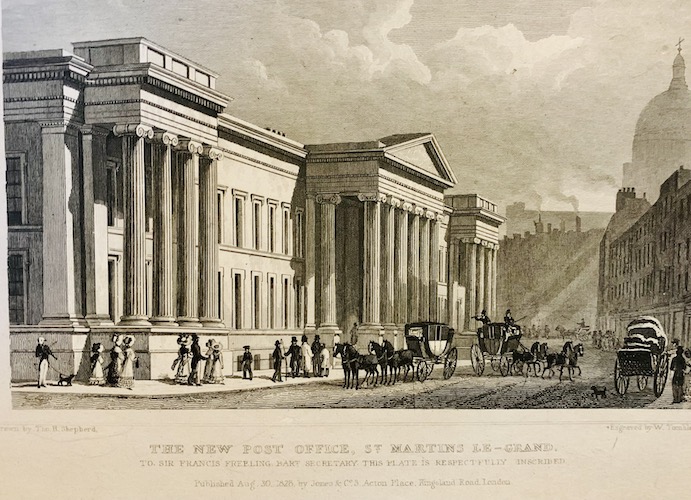At first glance this building could be mistaken for the British Museum. That would not be surprising. It was designed by the same architect – Sir Robert Smirke, the Greek revivalist – and built at around the same time as the BM in the 1820s. A contemporary description said it was “a post office concealed behind a front fit for a palace”. The only difference is that the British Museum is still standing proud in Bloomsbury while the General Post Office near St Paul’s has completely disappeared. It was pulled down in 1912 in what would today be described as an act of cultural vandalism.
Britain’s postal service can be traced back to a 1635 decision of Charles I (1625-1649) to allow the Royal Mail to be used for private correspondence. Eight years later, the first general post office opened on Cloak Lane off Dowgate Hill in the City. That building and others lasted a long time, and when rapid expansion became inevitable at the start of the 19th century the GPO started buying up slum property on the east side of St. Martin’s Le Grand. This cleared the way for the construction of Smirke’s 120 metre long tour de force, which was built between 1825 and 1829 and illuminated at night by a thousand gas burners.
Postal history in the 19th century is mainly remembered for a stroke of genius by Rowland Hill and a major innovation by the novelist Anthony Trollope, both of whom were employees of the Post Office. Hill successfully argued for a uniform rate for postage linked to weight rather than, as was the case then, being based on distance travelled and the number of pages within the envelope. Postage – bizarrely – was paid by the recipient rather than the sender. This gave rise to all sorts of fiddles as people sometimes put short coded messages on the envelope so the recipient could both read the message and refuse to accept delivery.
Hill’s proposals were supported by another genius, Charles Babbage, the “father of the computer”, who argued that the critical cost of the postal system was not transport but the complex handling procedures at both ends, which pre-paid stamps could hugely reduce. But his plan did not receive universal approval. The Postmaster, Lord Lichfield, denounced his “wild and visionary schemes.” while William Leader Maberly, Secretary to the Post Office, said: “This plan appears to be a preposterous one, utterly unsupported by facts and resting entirely on assumption.” But successful it was, and soon led to the introduction of the world’s first adhesive stamp, the Penny Black.
In the mid-1860s, Trollope, who had reached a moderately senior position within the Post Office despite differences with Hill, was credited with introducing the soon-to-be ubiquitous pillar-box.
Both of these innovations have been threatened by something neither Hill, Trollope or anyone else could have foreseen – that primary communications would need no stamps at all. The invention of emails has changed all that. It is quite possible in future that our only memory of the historic postal service will be the iconic post boxes – unless they too are lost in a fresh outburst of cultural vandalism.
Many of Vic Keegan’s Lost London columns have now been compiled into a handsome self-published book. Buy a copy HERE.
OnLondon.co.uk provides in-depth coverage of the UK capital’s politics, development and culture. It depends greatly on donations from readers. Give £5 a month or £50 a year and you will receive the On London Extra Thursday email, which rounds up London news, views and information from a wide range of sources, plus special offers and free access to events. Click here to donate directly or contact davehillonlondon@gmail.com for bank account details.


Might we have an early photo of the “Act of Vandalism” that replaced the General Post Office showing the forest of poles and wires on its roof carrying London’s early telephone system, before this was put underground.
Interesting thought. Any offers?
Thank you for a nice suscinct reminder of our fast fading postal service. How I miss receiving a painstaking handwritten letter! I can’t imagine an email being kept as letters were, so resonant of the sender by the handwriting.
Hampstead Garden Suburb, with its small letter slit regular placed letterboxes, has recently seemingly suffered a wave of ‘cultural vandalism’, either from vehicles backing into them or used to proclaim rather mysterious graffiti messages then only partially painted over in red, leaving the rest untouched & looking cheapskate.